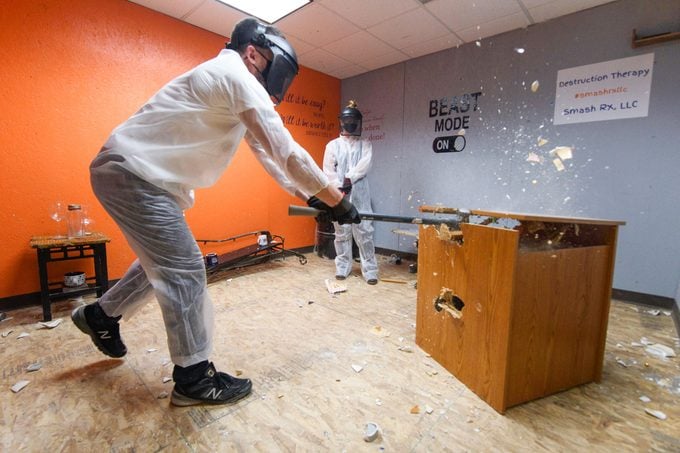Looking for a “Rage Room”? A Therapist Suggests You Should Know This One Thing
Updated: Feb. 25, 2022
Rage rooms are popping up all over the country. Is this fad a healthy way to deal with our pent-up emotions? Psychologists, along with two women who'd reached the boiling point, crack the case. (One even shares a way to create your own DIY rage room.)
From the first swing of the tire iron, Desiree Banka Rothenberger knew this was going to be one of the best birthday gifts ever…
We’ve all been a little extra “in our feelings” lately, and it’s nothing to be ashamed of. If you’ve had trouble making decisions, getting things done, or feeling very social or optimistic, it’s very possible you’re like the 84 percent of American adults who, in a late 2021 survey by the American Psychological Association, reported that prolonged stress was causing them emotional issues. The most common causes of that stress were fear for the future of our country and the coronavirus pandemic.
One of the most prevalent emotions among the survey’s participants was anger. That only makes sense, says Kelsey Torgerson Dunn, MSW, LCSW, an anger management specialist in St. Louis and author of When Anxiety Makes You Angry. Dunn explains that for many people, anger is the manifestation of their anxiety, stress, grief, fear, and sadness—sometimes, all combined.
These feelings have real-world consequences, as Helena Rempala, PhD, a clinical psychologist at the Ohio State University Wexner Medical Center, tells The Healthy. She adds that if it goes unchecked, anger can lead to mental and emotional disorders like depression and suicidality, as well as to physical problems like heart disease.
How to be less angry
Those are just a few of the reasons it’s important to find healthy outlets to deal when you’ve got difficult feelings. Healthy anger management can include seeing a therapist, talking to a loved one, exercising, meditating, journaling, and lately… smashing things?
Indeed sometimes it helps to express anger in a physical way, as long as you do it safely, Rempala says. Hitting inanimate objects in a space that’s designed for this, and in a way that’s safe for others, releases endorphins and can help you move past mental blocks keeping your anger in.
Does all this sound compelling? Enter: rage rooms.
What is a rage room?
We researched rage rooms around the country, and visited one in a major U.S. city, to learn the basics of how many tend to operate and what you can expect inside.
To explain it simply, a rage room is a space stocked with breakable items and the tools for you to break them with. Some rage rooms operate in conjunction with escape rooms or hatchet throwing, but they can also be standalone facilities. In some cases, the rage room offers packages for you to purchase for sessions you can share with friends. Prices vary widely by location, but expect to pay somewhere in the realm of $60 to $150 per session, or more.
A package might specify how much time you’re allotted inside the rage room, how many people are allowed to accompany you, what type and what number of items to smash, what tools you’ll have, and any extra equipment. A typical package is 20 to 30 minutes with about 50 breakable items that can include glassware, dishes, appliances, and electronics.
Before entering a rage room, you don protective gear (usually a helmet, goggles, and gloves), and are given a list of safety instructions. Activities inside a rage room include throwing, hitting, breaking, crushing, punching, and screaming. Some rage room spots allow you to plug in your own music so you channel your anger to your own soundtrack. (Also check out Do Wireless Earbuds Harm Your Brain? A Brain Cancer Doctor Sounds Off.)
Why do people go to a rage room?
Reasons for participating in a rage room range from sheer novelty and entertainment to anger management and major emotional catharsis.
Many people, like Desiree Banka Rothenberger, 42, seek them out as a type of therapy. “In March 2020, Covid canceled my wedding,” Banka Rothenberger tells The Healthy. “I went from my dream wedding to a quick ceremony in my living room.”

Rothenberger says from that point, as many Americans have experienced throughout the pandemic, life just kept presenting her with challenges. “I was so tired of having to be the strong one, and I was carrying so much pent-up anger,” says this Aurora, CO native. “I knew I couldn’t control my problems, but I could control my reaction, and I wanted to be able to let it out in a way that I wouldn’t have to feel bad about—or clean up—afterward. Plus, it just looked really fun.” Visiting a rage room was something this bold bride had been curious about. In early February 2022, that’s exactly what her husband’s birthday present to her was.
The reasons for seeking out a rage room were a little different for Marcy Allen, 38, of Seattle, WA, but the glory afterward was similar. After Allen’s brother died by suicide in 2021, she needed a way to express her complicated feelings. “I didn’t want to admit it, but I was really angry that he had died. It felt like he had made a conscious choice to leave me, and that made me furious and heartbroken,” she says. “I didn’t know what to do with all that anger. “
(This is what therapists suggest you should know about suicide.)
What do you do in a rage room?
Once Banka Rothenberger got inside, she attacked a printer, an air fryer, a vacuum, a small bathroom vanity, beer bottles, plates, and even a TV. When she got bored with the tire iron, she grabbed a metal baseball bat. “The glassware was the most satisfying,” she says. “My husband would toss a glass, and I’d hit it like a baseball. It was so fun!” (She adds that the TV was surprisingly difficult to break, but the printer was more exciting to smash than she’d expected.)
As for the effect, she says: “It was this incredible adrenaline rush, and I finally felt in control. It was such a relief after spending the past two years feeling like my world was shattering.”
DIY rage rooms
Allen didn’t have a rage room nearby, so she decided to make one for herself and her family. She purchased a variety of breakable things from a thrift store, like dishes and lamps, and set them up in a friend’s shed outside the city limits. Then, directly from her brother’s funeral, she and her family drove there. They took turns letting out their anger and grief, breaking every single item. One of the tools the family used was a BB gun to shoot items, as a way to honor her brother’s passion for shooting. (Allen tells us they were careful to clean up afterward, and not to leave any hazardous debris.)
Allen reflects that for her loved ones, the rage room experience was a powerful avenue for processing really tough emotions. “My dad was able to cry for the first time since finding out my brother died.” She also tells The Healthy that after her loved ones let it out, there were lots of tears and hugs all around—a sign of support and their first step in the journey toward healing. “It was one of the most cathartic things I’ve ever done,” Allen says. “It gave us a sense of closure. I felt like I got to say goodbye.” A cool plus? “My brother would have loved it,” she says.
What happens next
“I think we’d all be a lot healthier and happier if everyone could go to a rage room sometimes,” says Banka Rothenberger, adding that she’s already got plans to do one again. “It’s a great way to release anger without repercussions or causing harm.”
Rage rooms can be a piece of processing emotions. However, says Dunn, for big events, like ambiguous grief from the death of a loved one, it should be just one tool of many that you turn to as means to cope. Be sure to also practice journaling, meditation, exercise, or spending time with loved ones.
And if you’re feeling overwhelmed by your emotions—especially if you find yourself feeling angry all the time or experiencing bursts of uncontrollable rage—Dunn says that’s your way of knowing it’s time to seek professional help through a therapist.
Sign up for The Healthy newsletter for more healthy ways to deal with stress, plus answers to more of your health questions. Keep reading:



















